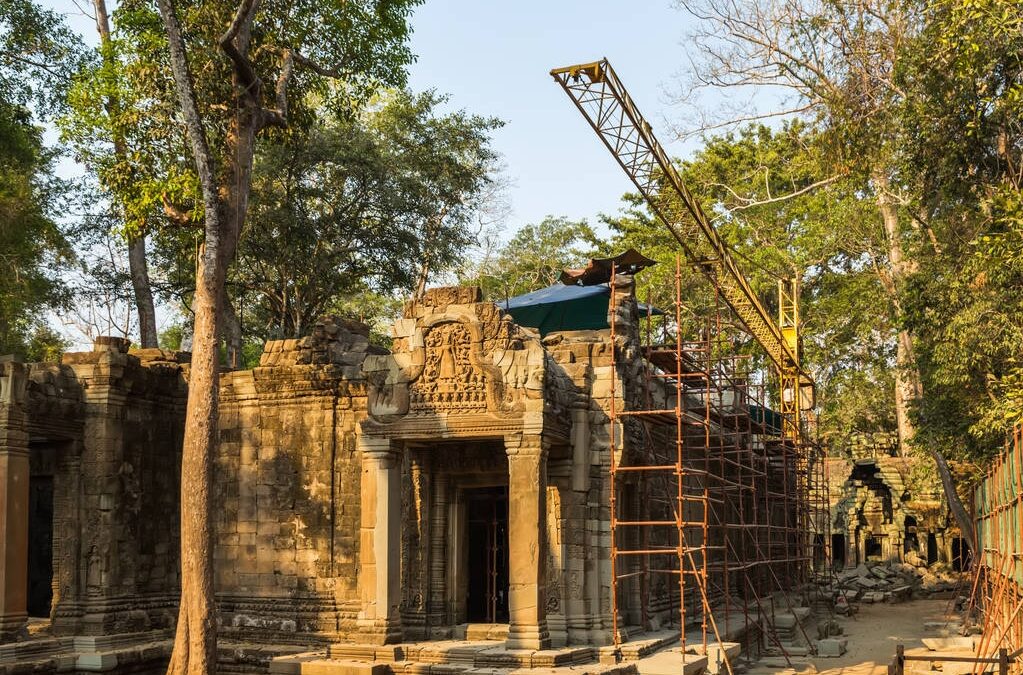There are major restoration work happening right now at Angkor Wat’s causeway, where crews are tackling cracked pillars and broken Naga balustrades since November 2024. They’re carefully dismantling damaged sections, removing old cement, and replacing worn elements with fresh sandstone. The APSARA National Authority‘s leading these efforts, with support from over 30 nations and UNESCO backing. There’s much more to uncover about this incredible preservation project’s technical innovations and upcoming phases!
Key Takeaways
- Major transformation of the causeway began in November 2024, including dismantling damaged sections and removing harmful old cement.
- APSARA National Authority is conducting critical restoration of the southern library and repairing damaged stone pillars.
- Teams are replacing deteriorated sandstone elements and returning original pedestals to their proper locations throughout the temple.
- Restoration of Naga balustrades is underway with support from international experts and community involvement.
- Japan has provided 94.7 million yen for Western Causeway restoration as part of ongoing international preservation efforts.
Current State of Angkor Wat’s Causeway Project
While Angkor Wat’s second terrace causeway has stood for centuries, it’s now undergoing a major transformation that began in early November 2024.
You’ll find the current causeway conditions are far from their original glory – with cracked pillars, broken Naga balustrades, and deteriorating repairs from previous attempts.
The restoration challenges are complex, but you’re witnessing history in the making!
Witness a monumental moment as skilled hands tackle the intricate puzzle of preserving Angkor Wat’s ancient splendor.
The team’s tackling these issues head-on by carefully dismantling damaged sections, removing old cement (that did more harm than good), and replacing missing elements with new sandstone.
They’re even tracking down original pedestals that had been relocated and returning them to their proper spots.
It’s like putting together a massive ancient puzzle, but this time with proper techniques that’ll help preserve this incredible structure for future generations to investigate.
Historical Restoration Timeline at Angkor Wat
Three major phases have shaped Angkor Wat’s restoration expedition since its “rediscovery” by Western adventurers in 1860.
You’ll be fascinated to learn how French pioneers initiated the initial phase in 1866, establishing the EFEO in 1898 to preserve this temple’s historical significance. Talk about dedication!
The second phase saw dramatic ups and downs – from intense restoration work in the 1960s to a complete halt during Cambodia’s Civil War.
The restoration challenges were immense, but that didn’t stop international teams from jumping in to help. By 1992, UNESCO had recognized Angkor Wat’s importance, leading to the third phase.
Today, you’re witnessing history in action as APSARA (established 1995) coordinates with teams from France, India, Japan, and China to protect this architectural marvel for future generations.
APSARA National Authority’s Latest Conservation Work
Since its establishment in 1995, APSARA National Authority has taken on some of Angkor Wat’s most ambitious restoration projects to date.
You’ll find their latest work focusing on the southern library’s critical restoration, where they’ve tackled severely deteriorating stone pillars and structural cracks in this 1,000-year-old building.
What’s really exciting is how they’re handling conservation challenges!
APSARA’s team is meticulously dismantling sections of the temple’s causeway, replacing damaged stones, and restoring the iconic Naga balustrades to their former glory.
They’re not doing it alone – through partnerships with international experts and increased community involvement, they’ve created a thorough preservation strategy.
While managing these massive projects, they’re also ensuring that you’ll be able to experience Angkor Wat’s magnificent architecture for generations to come.
International Support and Funding for Temple Preservation
The preservation of Angkor Wat has become a remarkable global effort, with organizations from over 30 nations joining forces to protect this architectural gem.
You’ll be amazed by the scale of international collaboration happening right now – UNESCO‘s leading the charge through ICC-Angkor, while the World Monuments Fund’s been hard at work since 1989!
When it comes to funding strategies, you’re looking at some serious commitment. Japan’s stepped up with an impressive 94.7 million yen just for the Western Causeway restoration, and France is pitching in with specialized training programs.
The best part? These aren’t just one-off projects – they’re creating lasting change by training local Cambodian experts.
From UNESCO’s coordinated efforts to WMF’s climate change initiatives, it’s YOUR heritage they’re protecting for future generations!
Major Achievements in Temple Structure Rehabilitation
As ongoing restoration projects transform Angkor Wat’s ancient stones, you’ll find remarkable achievements in structural rehabilitation throughout the complex. You can witness stone conservation efforts firsthand at the second terrace’s causeway, where APSARA teams are meticulously dismantling and repairing damaged sections – it’s quite a sight!
The restoration team’s dedication to structural integrity is impressive. They’re removing old cement repairs, replacing missing pedestals and pillars with fresh sandstone, and returning displaced elements to their original positions.
At the famous Churning of the Sea of Milk Gallery, you’ll see the World Monuments Fund tackling critical issues like water damage and salt infiltration. They’re preserving what’s possibly the temple’s most ambitious stone carvings, ensuring you’ll be able to admire these masterpieces for generations to come!
Technical Innovations in Ancient Stone Restoration
Modern technological breakthroughs have revolutionized the way you’ll see Angkor Wat’s ancient stones being preserved today. The latest innovations in sandstone preservation are nothing short of amazing!
Experts are using ethyl silicate to bind and protect the stone surfaces, while ultrasonic assessment helps them quickly spot and treat decay before it’s too late.
Revolutionary restoration techniques combine ethyl silicate treatment with ultrasonic scanning to save Angkor Wat’s ancient stones from deterioration.
You’ll find restoration teams working smarter, not harder, with computerized documentation tracking every detail of water damage and erosion.
They’re even managing those massive strangler fig trees – turns out, some roots actually help hold ancient carvings together!
And here’s the coolest part: international experts aren’t just fixing things up and leaving. They’re training local Cambodian conservators to maintain these incredible innovations, ensuring Angkor Wat’s future is in capable hands.
Upcoming Restoration Projects and Partnerships
Since Angkor Wat’s future depends on careful preservation, you’ll be excited to learn about the incredible partnerships coming together for its next phase of restoration!
You’re about to witness some AMAZING collaborations between international experts and local communities, all working to protect this magnificent site. The latest projects focus heavily on community engagement and cultural pride, ensuring that both visitors and locals can enjoy this wonder for generations to come.
Here’s what’s happening right now:
- APSARA National Authority’s restoration of the second terrace causeway
- Korea Cultural Heritage Foundation’s work on the Bakheng Terrace (running through 2026!)
- UNESCO’s ongoing Bayon Temple conservation efforts
- A massive collaboration involving experts from 30 different nations
These projects aren’t just about fixing stones – they’re about bringing people together to preserve history while creating sustainable solutions for the future!
Conclusion
You’re witnessing one of history’s most ambitious heritage preservation projects unfold at Angkor Wat. Through groundbreaking stone conservation techniques, international partnerships, and the APSARA Authority’s dedicated efforts, this magnificent temple complex is getting the care it needs. While there’s still much work ahead, you’ll see continued progress in structural repairs, causeway restoration, and cutting-edge preservation methods that’ll help protect this wonder for future generations to investigate!



